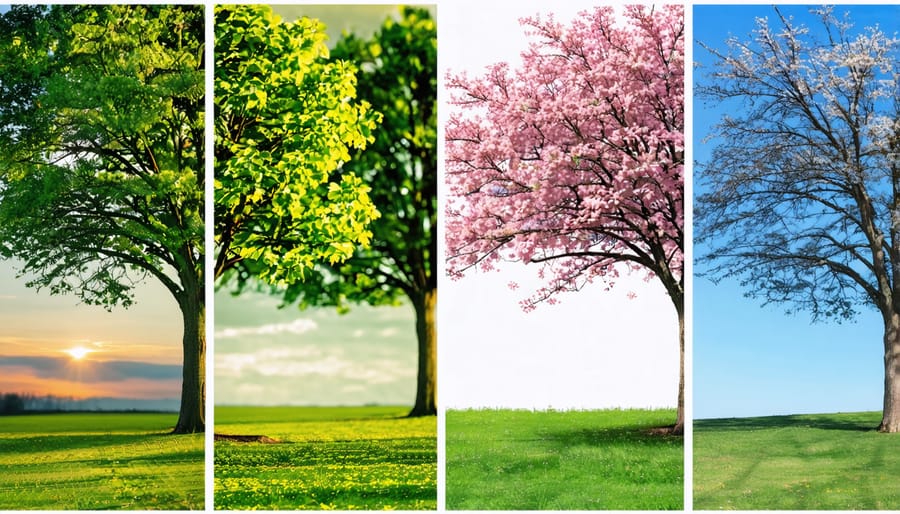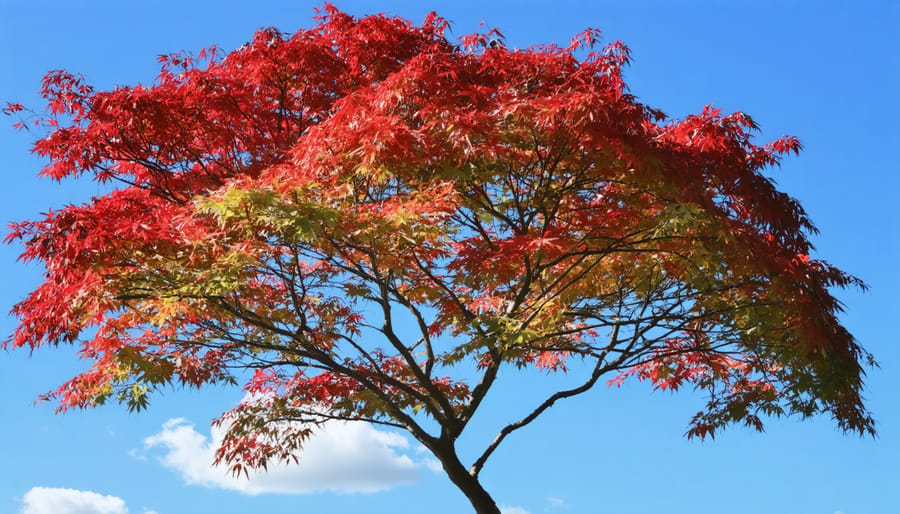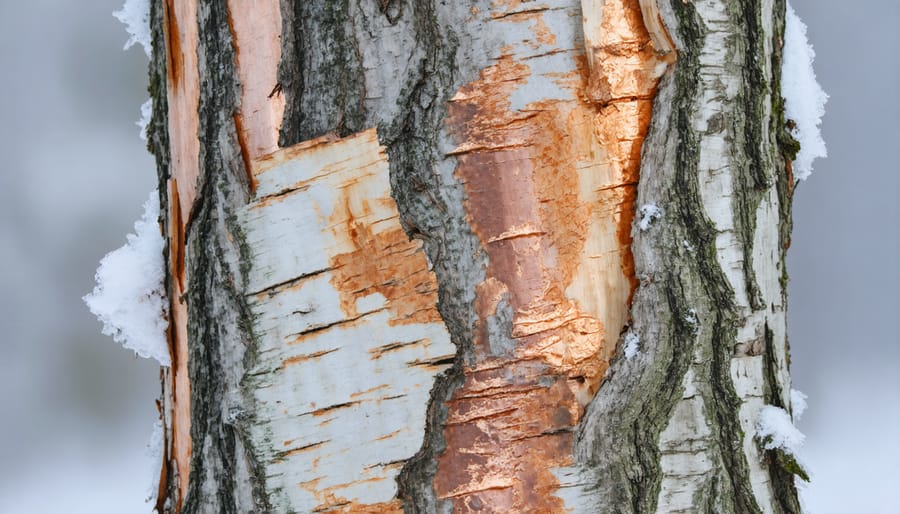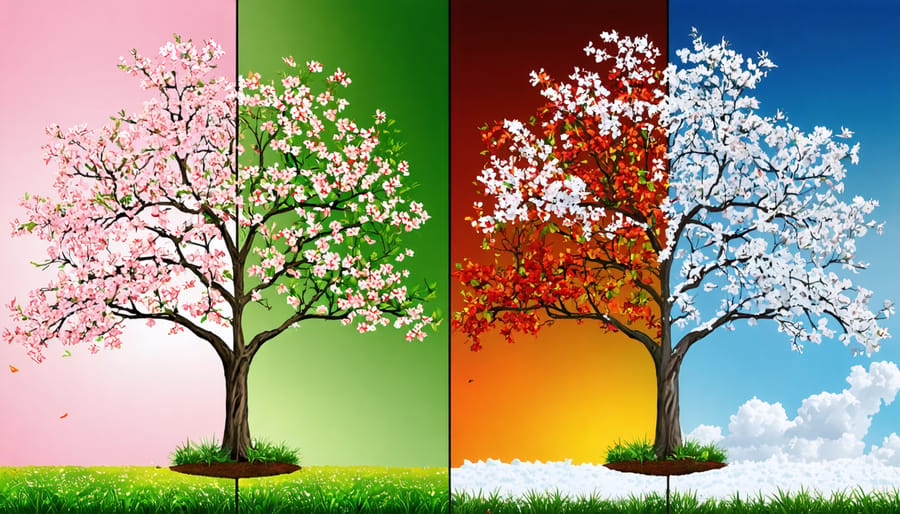Transform your landscape into a living masterpiece by selecting trees that captivate through all four seasons. While most gardens fade during winter, a thoughtfully planned four-season tree collection maintains its splendor year-round. Learn to design a tree garden that transitions seamlessly from spring’s delicate blossoms to summer’s lush canopies, autumn’s fiery displays, and winter’s architectural beauty. Japanese maples offer burgundy spring leaves and scarlet fall color, while paper birch combines summer shade with striking white winter bark. River birch and dogwood trees deliver multiple seasons of interest through changing foliage, beautiful bark patterns, and distinctive branch structures. By carefully selecting these botanical champions, your garden becomes a dynamic showcase of nature’s ever-changing beauty, requiring minimal maintenance while providing maximum visual impact throughout the year.

Spring: Setting the Stage for Year-Round Beauty
Early Spring Care Essentials
As winter releases its grip, your four-season tree needs special attention to ensure a vibrant spring display. Start with a thorough inspection of your tree, looking for any damage from winter storms or frost. This is the perfect time for ornamental tree pruning, focusing on removing dead, damaged, or crossing branches while the tree is still dormant.
Early spring fertilization is crucial for supporting new growth. Apply a balanced, slow-release fertilizer when the soil temperature reaches about 40°F (4°C). Spread it evenly around the tree’s drip line, but avoid direct contact with the trunk to prevent burning.
Don’t forget about pest prevention! Early spring is when many overwintering insects become active. Apply dormant oil spray before buds break to suffocate any eggs or larvae that might have survived winter. This organic approach helps protect your tree without harsh chemicals.
Mulching is another essential spring task. Refresh your mulch layer to about 2-3 inches deep, keeping it away from the trunk to prevent moisture-related issues. This helps retain soil moisture and suppress early spring weeds that compete for nutrients.
Finally, check your tree’s soil moisture levels regularly. Spring rains can be unpredictable, so ensure your tree receives about an inch of water weekly, adjusting for rainfall. Remember, proper spring care sets the foundation for healthy growth throughout the entire growing season.
Spring-Interest Tree Selection
Spring brings the most dramatic transformation to our gardens, and selecting the right trees for this season can create a spectacular display of colors and textures. Among the top choices for spring interest, flowering cherries and crabapples steal the show with their ethereal clouds of pink and white blossoms. The Yoshino Cherry, in particular, creates a breathtaking canopy of delicate flowers that seems to float in the early spring breeze.
For those seeking something different, consider the Eastern Redbud, which produces stunning purple-pink flowers directly on its branches before the leaves emerge. This unique flowering pattern, known as cauliflory, creates an artistic silhouette against the spring sky. The Dogwood family offers another excellent option, with varieties featuring white, pink, or even red blooms that persist for several weeks.
Magnolias are perfect for making bold statements in spring gardens. The Star Magnolia, with its pristine white flowers, and the Saucer Magnolia, showcasing large, purple-pink blooms, both bloom early and create unforgettable displays. For smaller spaces, the Japanese Maple provides elegant spring interest with its emerging leaves in shades of red, orange, or chartreuse.
When selecting spring-interest trees, consider their placement carefully. Choose locations where you can enjoy the blossoms from indoor viewing areas and ensure the trees have enough space to reach their full potential without overcrowding.
Summer: Maximizing Shade and Color
Summer Maintenance Tips
Summer brings unique challenges for tree care, but with proper attention, your trees can thrive during the hottest months. Regular watering becomes crucial during this season – aim to provide deep, thorough watering rather than frequent light sprinklings. A good rule of thumb is to water deeply once or twice a week, adjusting based on rainfall and soil moisture levels.
Mulching is your tree’s best friend in summer, helping retain moisture and regulate soil temperature. Apply a 2-3 inch layer of organic mulch around your tree’s base, keeping it away from the trunk to prevent rot. Combined with proper soil management techniques, mulching can significantly reduce water stress and promote healthy root development.
Summer also brings increased pest activity. Regular inspections are essential – look for signs of insect damage on leaves, unusual spots, or wilting. Consider introducing beneficial insects like ladybugs to naturally control pest populations. If you spot potential issues, address them promptly using eco-friendly solutions before they become severe.
Don’t forget to monitor for heat stress symptoms, such as leaf scorching or premature leaf drop. Providing afternoon shade for younger trees can help protect them during intense heat waves. Remember to avoid fertilizing during periods of drought or extreme heat, as this can stress the tree further.
Best Trees for Summer Interest
Summer brings endless opportunities for garden beauty, and certain trees truly shine during the warmer months. Japanese Maples offer stunning displays with their delicate, colorful foliage that ranges from deep burgundy to bright chartreuse. Their graceful form creates perfect dappled shade for summer relaxation spots.
Crape Myrtles are summer showstoppers, producing abundant clusters of pink, purple, red, or white blooms that last for weeks. These heat-loving trees also feature attractive, peeling bark and maintain their vibrant display even during the hottest days.
For fragrant summer charm, consider the Southern Magnolia, whose large, glossy leaves provide a stunning backdrop for their massive, creamy-white blooms. The sweet perfume of these flowers can fill an entire garden with their delightful scent.
Don’t overlook fruit trees for summer interest. Apple, cherry, and pear trees transition from spring blossoms to developing fruit, adding both visual appeal and the promise of a future harvest. Their changing fruit colors create an evolving display throughout the season.
Catalpa trees make excellent summer specimens with their large, heart-shaped leaves and showy white flower clusters. These native trees also provide valuable shade during hot summer days while creating beautiful patterns on the ground below.
For smaller spaces, consider the Golden Rain Tree, which produces bright yellow flower clusters in mid-summer, followed by interesting papery seed pods that add textural interest well into fall.
Fall: Preparing for Seasonal Transition
Fall Preparation Strategies
As autumn’s crisp air settles in, it’s time to prepare your four-season tree for the challenges of winter. Start by clearing away fallen leaves and debris from around the base of your tree – this prevents moisture buildup and discourages pests from making a winter home. However, don’t discard those leaves! They make excellent compost material when mixed with other organic matter.
Now is the perfect time to give your soil some extra attention. Test the pH levels and add amendments as needed. A balanced fertilizer with lower nitrogen content but higher phosphorus and potassium will help strengthen your tree’s root system before winter arrives. Work the amendments gently into the top layer of soil, being careful not to disturb the tree’s roots.
Consider adding a 2-3 inch layer of mulch around your tree, keeping it about 6 inches away from the trunk. This insulating blanket helps regulate soil temperature and retains moisture through winter’s freeze-thaw cycles. For younger trees, you might want to install protective wrapping around the trunk to prevent winter sun scald and damage from animals.
Before the first frost, give your tree one final deep watering. This ensures it has adequate moisture reserves to sustain it through winter. Take this opportunity to inspect for any damaged or diseased branches and prune them away – clean cuts heal better before the dormant season begins.
Remember to protect any sensitive surface roots with an extra layer of mulch, and consider installing wind breaks if your tree is in an exposed location.
Trees with Outstanding Fall Color
When it comes to creating a spectacular autumn display, certain trees truly steal the show with their vibrant fall colors. The Sugar Maple stands out as a champion of fall foliage, transforming from deep green to brilliant oranges, reds, and yellows. This native tree not only provides excellent shade during summer but rewards patience with a breathtaking autumn finale.
Japanese Maples offer exceptional variety in fall colors, with different cultivars displaying deep crimson, burnt orange, or golden yellow leaves. Their smaller size makes them perfect for urban gardens and patios. The Sweetgum is another showstopper, with star-shaped leaves that turn purple, red, and orange, often holding their color longer than other species.
For reliable golden fall color, consider the Ginkgo biloba. All its leaves tend to turn and fall within a few days, creating a stunning golden carpet beneath. The Red Oak delivers dependable russet and burgundy tones, while the Tupelo (Black Gum) offers early color changes with leaves ranging from yellow to scarlet and purple.
For smaller spaces, consider the serviceberry, which combines spring flowers and edible summer berries with orange-red fall foliage. The Dogwood is another excellent choice, offering spring blooms followed by deep purple-red autumn leaves and attractive winter bark.
Remember that fall color intensity depends on environmental factors like soil conditions and weather patterns, but these species consistently rank among the most reliable performers for autumn displays.

Winter: Maintaining Interest in Dormancy
Winter Protection Methods
Protecting your trees during winter is crucial for maintaining their health and ensuring they continue to provide year-round beauty. A comprehensive winter tree protection plan involves several key strategies that any gardener can implement.
Start by wrapping young or thin-barked trees with tree wrap or burlap from the base up to the first major branches. This prevents sunscald and protects against frost cracks that can occur when bark warms during sunny winter days and rapidly cools at night. Apply a 3-4 inch layer of mulch around the tree’s base, keeping it a few inches away from the trunk to prevent moisture buildup and rodent damage.
For smaller trees, consider using a protective barrier or fence to shield them from harsh winds and heavy snow loads. These barriers can be as simple as three or four stakes with burlap stretched between them on the windward side of the tree.
Don’t forget to continue watering your trees until the ground freezes. Well-hydrated trees are more resistant to winter damage. If you live in an area with heavy snow, gently brush off accumulated snow from branches to prevent breakage, but avoid shaking them as cold branches can be brittle.
Remember to remove all protection materials in early spring to prevent moisture buildup and allow proper air circulation as temperatures warm.
Trees with Winter Appeal
While many trees retreat into dormancy during winter, several species put on a spectacular show even in the coldest months. The Paper Bark Maple stands out with its cinnamon-colored bark that peels elegantly, creating visual interest against winter’s stark backdrop. River Birch trees also shine in winter, featuring exfoliating bark in shades of cream, salmon, and brown that catches the eye even from a distance.
For those seeking winter color, consider the American Holly, whose bright red berries persist throughout the season while providing essential food for winter birds. The Japanese Maple family offers stunning architectural appeal with their graceful branching patterns, particularly visible after leaf fall. The Coral Bark Maple variety displays vivid red stems that seem to glow against winter snow.
Don’t overlook the enchanting appeal of the Harry Lauder’s Walking Stick, whose twisted, contorted branches create fascinating shadows and silhouettes during winter months. The Seven Son Flower tree features attractive peeling bark and persistent brown fruits that add textural interest to the winter landscape.
For smaller spaces, consider the Paperbark Cherry, which combines beautiful mahogany-colored bark with a compact growing habit. These winter champions prove that a garden can maintain its allure even during the coldest season, providing structure, color, and wildlife habitat when other plants are dormant.

Creating a four-season tree garden is more than just a landscaping project – it’s an investment in year-round beauty and enjoyment of your outdoor space. By carefully selecting trees that offer different attractions throughout the year, you can transform your garden into a dynamic, ever-changing landscape that delights in every season.
Remember that successful four-season planning starts with understanding your local climate and choosing trees that will thrive in your specific conditions. Consider factors like available space, sunlight exposure, and soil type when making your selections. The key is to create layers of interest by combining trees with different flowering times, fall colors, winter bark patterns, and spring growth habits.
Don’t feel overwhelmed by the prospect of planning for all four seasons at once. Start small by selecting one or two anchor trees, then gradually add more varieties as you become more confident in your gardening abilities. Pay attention to how your chosen trees perform throughout the year, and keep a garden journal to track their seasonal changes.
The rewards of four-season tree planning are well worth the initial effort. You’ll create a landscape that provides shelter for wildlife, adds value to your property, and brings joy throughout the entire year. Whether you’re watching spring blossoms unfold, enjoying summer shade, admiring autumn colors, or appreciating winter silhouettes, your thoughtfully planned garden will be a source of endless satisfaction.
Take the first step today by assessing your space and choosing your first four-season tree. Your future self will thank you for creating such a beautiful, sustainable, and ever-changing landscape.




